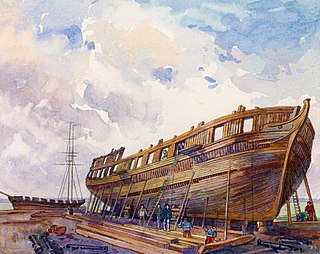
Presqu'ile Provincial Park is a park in southeastern Northumberland County on the north shore of Lake Ontario near the town of Brighton in Ontario, Canada. The park occupies an area of 9.37 km2 (3.62 sq mi). The name of the park is the French word for peninsula, or literally "almost island", and was believed to be named by Samuel De Champlain on his second expedition. The peninsula was formed when a limestone island was connected to the mainland by a sand spit; this kind of formation is referred to as a tombolo.

HMS Royal George was a British 20-gun wooden sloop of the Provincial Marine, and subsequently, the Royal Navy, operating on Lake Ontario during the War of 1812. The vessel took part in several Engagements on Lake Ontario and was the flagship of the Provincial Marine at the First Battle of Sackett's Harbor. In 1814, the vessel was renamed Niagara. Following the war, the sloop was converted to a transport and sold in 1837.

HMS Duke of Gloucester was a 10-gun brig of the Royal Navy which was launched at the Kingston Royal Naval Dockyard in Kingston, Ontario. A Provincial Marine vessel, during the War of 1812, the brig took part in several of the early engagements between British and American naval forces on Lake Ontario and the St. Lawrence River. While being repaired at York, Duke of Gloucester was captured by Americans in 1813. A month later the British destroyed the brig at the Battle of Sackett's Harbor.

HMS St Lawrence was a 102-gun first-rate wooden warship of the Royal Navy that served on Lake Ontario during the War of 1812. Built on the lake at the Royal Navy dockyard in Kingston, Ontario, she was the only Royal Navy ship of the line ever to be launched and operated entirely in fresh water. Constructed in 1814, the ship's arrival on the lake ended all naval action and St Lawrence finished the war having never gone into battle. Following the war, the vessel was laid up, eventually being sold in 1832 to private interests. The ship later sank and is now a recreational dive spot.

Robert Isaac Dey Gray was a lawyer, judge and political figure in Upper Canada.
Toronto was a schooner of the Provincial Marine, built by John Dennis on the Humber River at York (Toronto), Upper Canada that entered service in 1799 on the Great Lakes. The ship was built to ferry government officials from York to Upper Canada's former capital of Newark. The ship's career was short; she was wrecked in 1811 off Hanlan's Point and was broken up.

HMS Princess Charlotte, later HMS Burlington, was a 42-gun fifth-rate frigate of the Royal Navy built in 1814, during the War of 1812 at the Kingston Royal Naval Dockyard in Kingston, Ontario. She had originally been built as Vittoria, but was renamed before being launched. She was constructed to a design by George Record, and was built under a private contract by Master shipwright John Goudie. She served on Lake Ontario, having been commissioned at Oswego on 5 May 1814 under Captain William Mulcaster.

HMS Sir Isaac Brock was a warship which was destroyed before being completed at York, Upper Canada during the War of 1812. The ship was named after the famed hero of the war, Major General Sir Isaac Brock.

The Kingston Royal Naval Dockyard was a Royal Navy Dockyard from 1788 to 1853 in Kingston, Ontario, Canada, at the site of the current Royal Military College of Canada.
HMS Prince Regent was a 56-gun British warship that served on Lake Ontario during the War of 1812. Prince Regent was built at the Kingston Royal Naval Dockyard in Kingston, Upper Canada and launched on 14 April 1814. Rated as a fourth-rate frigate, Prince Regent took part in the Raid on Fort Oswego in 1814. Following the War of 1812 the frigate was renamed HMS Kingston on 9 December 1814. In 1817, the vessel was placed in reserve following the Rush-Bagot Treaty that demilitarized all the lakes along the United States-Canada border. Discarded in 1832, the vessel found no buyer and sank in Deadman Bay off Kingston after 1832.
HMS Moira was a British 14-gun schooner of the Royal Navy, that plied the waters of Lake Ontario and the St. Lawrence River during the War of 1812. Initially constructed for the Provincial Marine in 1805, the vessel took part in the Engagements on Lake Ontario. Renamed Charwell in 1814, following the war, the vessel became a powder hulk and an accommodation vessel. The vessel was sold in 1837.

HMS Wolfe was a 20-gun sloop-of-war, launched at the Kingston Royal Naval Dockyard at Kingston, Upper Canada, on 22 April 1813. She served in the British naval squadron in several engagements on Lake Ontario during the War of 1812. Upon her launch, Wolfe was made the flagship of the squadron until larger vessels became available. Along with the naval engagements on Lake Ontario, Wolfe supported land operations in the Niagara region and at the Battle of Fort Oswego. Following the war, the vessel was laid up in reserve and eventually sold in 1832.
HMS Lord Melville was a brig of the Royal Navy launched at Kingston, Ontario, on 20 July 1813. Initially designed as a schooner, she was altered to 14-gun brig in 1813. She served on Lake Ontario during the War of 1812, and was renamed HMS Star on 22 January 1814. By 1815, she was unfit for anything but transport duties. She was sold in 1837.
USS Lady Prevost was a schooner captured from the British during the War of 1812 and pressed into use in the United States Navy.
HMS General Hunter was a 10-gun brig of the Upper Canada Provincial Marine then, in 1813, the Royal Navy for their squadron on Lake Erie. She was ordered and built as a schooner in 1806 to replace Hope, a Provincial Marine vessel that had run aground in 1805. General Hunter was launched in 1807, entering service that year. With the outbreak of the War of 1812, General Hunter was converted to a brig and rearmed. As part of the Lake Erie squadron, General Hunter was present at the Battle of Lake Erie where the United States Navy defeated the British and gained control of the lake. General Hunter was captured at the battle and taken into American service. With the ship's name shortened to Hunter, she was used as a transport for the rest of the war. Following the war, the ship was sold into mercantile service. In 1816, the ship ran aground in a storm on Lake Huron and wrecked. The ship's contents were salvaged, but the wreck was left to be buried under the sand. In 2004, the wreck became the site of archaeological excavations and artifacts were retrieved from the site and placed in museums.

HMS St Lawrence was a 14-gun schooner of the Royal Navy. She had been built in 1808 in St. Michaels, Talbot County, Maryland for Thomas Tennant and sold to Philadelphians in 1810. During the War of 1812 she was the US privateer Atlas. The UK captured her in 1813 and renamed her St Lawrence. The US privateer Chasseur recaptured her in 1815, and then HMS Acasta re-recaptured her.

HMS Epervier was an 18-gun Cruizer-class brig-sloop of the Royal Navy, built by Ross at Rochester, England, and launched on 2 December 1812. USS Peacock captured her in 1814 and took her into service. USS Epervier disappeared in 1815 while carrying dispatches reporting the signing of a treaty with the Dey of Algiers.
Several ships have been named Tigris for the Tigris River:












